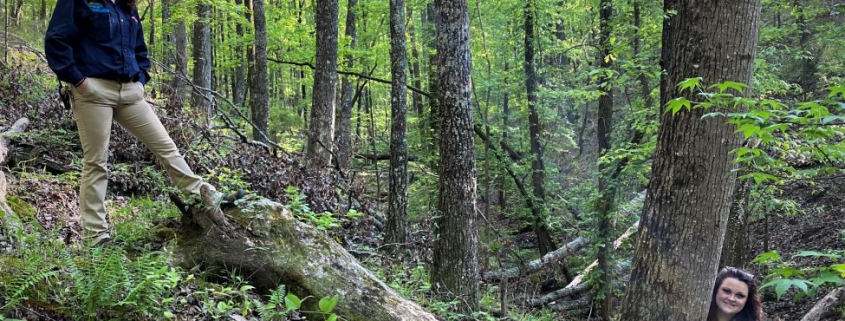Oak Mountain State Park April Tree Form Curiosities
Tree Form Oddities and Curiosities
Marker Trees?
My February, 2021 Post addressed the fact and folklore of the so-termed Indian marker trees I encountered during a January 2021 hike in the bottomland hardwood forests on the eastern end of Wheeler National Wildlife Refuge: https://stevejonesgbh.com/2021/02/10/indian-marker-trees-separating-folklore-from-fact/
My conclusion in that Post was that most of northern Alabama’s supposed Indian marker trees post-date the presence of Native Americans, and that Nature’s tree form oddities usually have an identifiable cause in form of physical injury. In all honesty, even genuine marker trees resulted from an intentional human-induced physical injury.
April 14-16, 2021 I spent three half-days hiking at Oak Mountain State Park (Pelham, AL). I kept my eyes open for all manner of Nature’s wonder, including tree form oddities and curiosities. None of what triggered my camera (many images below) is an Indian marker tree, although I realize that many persons who champion the Native American attribution for such forms would contest my conclusion. For each photograph I will offer a suspected cause. I often quote Leonardo da Vinci, who 500 years ago mastered the art of acute observation and reasoned judgement:
There is no result in nature without a cause; understand the cause and you will have no need of the experiment.
Scottie Jackson, Central District Naturalist (left), stands with her left foot on what was the toppled stump of a sapling sweetgum. Some force (wind, ice, a tree or large branch falling on it) felled the young tree, lifting its upslope roots. Enough of its downslope roots remained intact to sustain life in the prostrate stem. Oak Mountain State Park Naturalist Lauren Muncher stands ten feet from Scottie at the point where the felled sapling stem severed (its calloused-over stub remains) and the still-vibrant tree produced a new vertical shoot that now reaches into the main canopy. An Indian marker tree? No, the cause is Nature at work, employing her seeming limitless power to overcome physical insult and injury. I am sure that Native Americans learned to create their marker trees by observing Nature in practice.
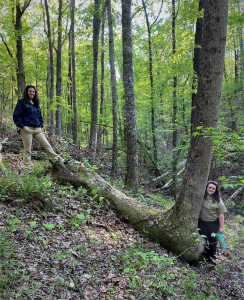
Nature knows her stuff. Like the sweetgum above, this American beech (as a sapling) toppled. Scottie is kneeling at its then-base. Lauren stands 12 feet away where the beech sent its shoot skyward, in this case into the intermediate forest canopy. Beech is shade tolerant and can survive long-term without being in the main canopy.
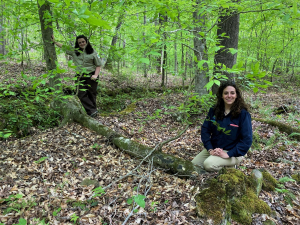
Here’s a closer look at both points. Examining both the sweetgum and the beech revealed a great deal. It also raised a question to which I have no firm answer. That is, along the felled stems did either or both individuals set new roots in addition to those still in soil-contact from the toppled base? Perhaps on some future outing I will carry my Sharpshooter spade in search of a similar tree so that I can answer the question. Based upon the less-than-vigorous appearance of the segment lying on the ground for both individuals, I am offering the hypothesis that the stems rooted at the point where the vertical shoot now extends.
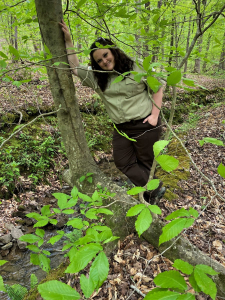
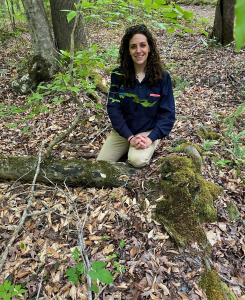
As with so many of my photographed tree form oddities, I ask you to imagine. Imagine this now 18-inch diameter yellow poplar as a pole-sized tree being slammed to 30-degrees from the horizontal by a sizeable object…a falling tree or large branch, the impact severe enough to snap the top ten feet above the stump. This individual employed the mechanism stuffed in its genetic toolbox through countless yellow poplar generations — its internal chemistry stirred a dormant bud on its nearly prostrate bole. That bud awakened via growth hormones to send a shoot vertically, now extending into the main canopy. Is the bent stem pointing to something? Yes, everything points to something. Is it intentionally by some act of man pointing to something? No, this is a random act by Nature’s hand.
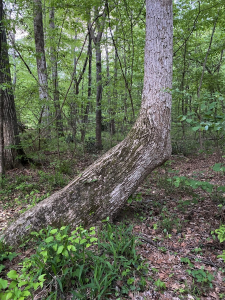
Here is an act occurring within the past year. A dead snag, probably this past dormant season, broke at its base, falling into a sugar maple sapling. The sugar maple now leans about ten degrees from the vertical. The impact snapped the maple ten feet above its base. I predict that the top will die beyond the break and that the leaning ten-foot base will activate a dormant bud or two, producing a stem that will reach into the mid-canopy. Like beech, sugar maple is shade tolerant and can survive under the main forest canopy for decades. This is a future tree-form curiosity.
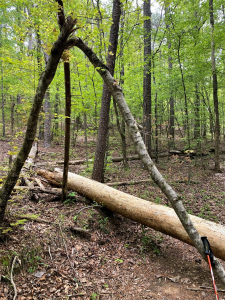
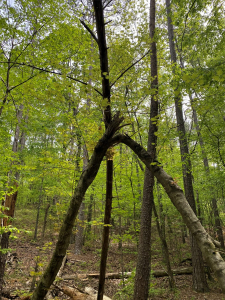
Nature has no new tricks. Any force that acted decades (millennia) ago is still happening today. I accept the fortuity of finding the recent evidence of such a force at work on the sugar maple. In my ideal world, the on-park Naturalist would note the location of this future marker tree, and visit it every five years to develop a photo-chronology. The tree will either do as I predict…or not. If the former, the permanent photo record will serve as a resource for telling a tale repeated time and again in our forests.
Contorted and Misshapen
This American beech at Maggie’s Glen, I am sure, has a tale to tell. It has stood streamside for well over a century, witnessing Nature’s cycles and hundreds of hikers, picnickers, and campers. Far too many young lovers (and vandals) have carved their fleeting thoughts and initials into its bark. Perhaps an ill-placed campfire scorched and opened the wound that led to its hollowed state.
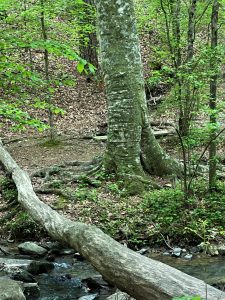
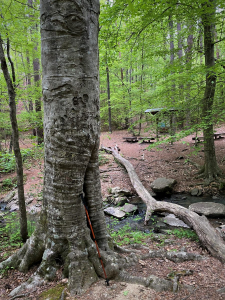
Trees don’t start out in life with a mission to develop in a manner that enables forest travelers like me to see from one side to the other. Oh, the wonder of hearing the stories this beech could tell!
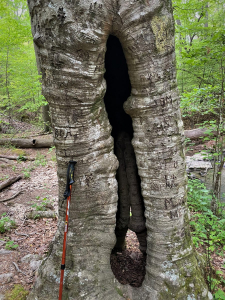
Here’s a formerly forked black oak, which is trying to callous over the injury caused by the other fork wrenching apart. Even were the ceaseless efforts to succeed in fully callousing over the wound, the tree is destined to live with heart rot until some force sees through the façade and topples it.
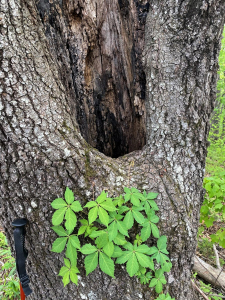
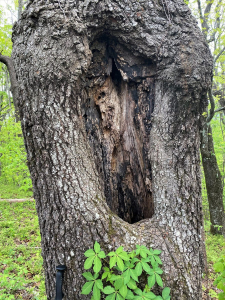
Recall the sugar maple above. The maple (below left) may predict what the earlier tree will look like 10-20 years hence. I’m standing below right with a red oak that suffered a similar physical insult. Both trees are alive…and both will deal the rest of their days with severe heart rot.
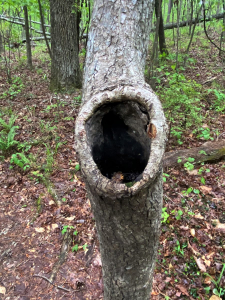
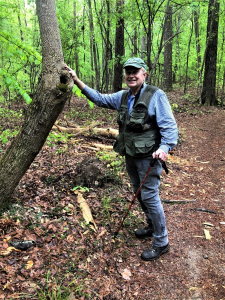
This large yellow poplar lost its twin fork decades ago, long enough that no on-the-ground evidence of its fallen twin is visible. The tree continues it valiant efforts to callous over the wound. But valiant and successful don’t always overlap. Deep heart rot has already structurally weakened this individual. Will it break at the base due to the decay? I can’t be sure. The view to its crown shows it reaching into a co-dominant position. Despite its wound, the tree appears otherwise healthy and competitive.
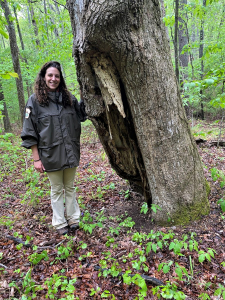
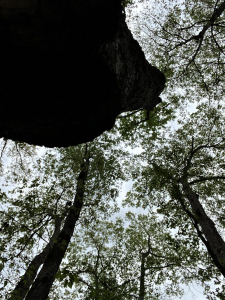
Here’s testament that hollow is not imminently fatal. Who knows how long this American beech survived with just a circumferential rind of cambium and intact wood. It toppled, along with many solid-stemmed forest trees, summer of 2020 when the tropical storm strength remnants of one of the many gulf hurricanes shot northward across central Alabama.
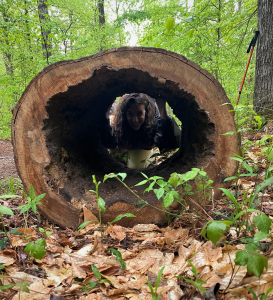
Nature renders many forest occupants battered, contorted, and misshapen. I find fascination in both the cause and the result.
Multiple Stems
I recently taught an Osher Lifelong Learning Institute (at the University of Alabama in Huntsville) course focusing on our Land Trust of North Alabama. I incorporated several photographs of trail-side trees forked at near-ground level. Participants questioned me about the origin and relative frequency of such multiple-stemmed trees. I explained that many of our hardwood forests regenerated from stump sprouts following timber harvesting. Oaks, among several species, are prolific sprouters. This five-stemmed chestnut oak stump sprout cluster is a classic. Imagine a freshly cut stump in the center of today’s five stems. Now, visualize multiple dormant buds sprouting from the stump. There may have been (in fact, probably were) more than these five survivors. The photo below right views upward from the center of the five. Four of the five are growing somewhat straight, leaning out from the vertical so that each has its own crown space in the main canopy. The fifth stem (upper right of the image) curves away from the other four. It probably fell behind the others in height gain, resulting in its sharper angle away to get out from under their shade.
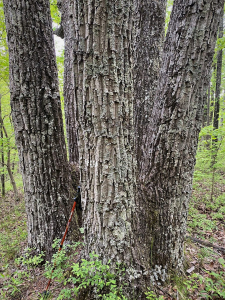
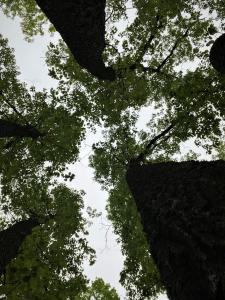
Multiple stemmed individuals are common in our second growth hardwood stands. To some, I suppose, a curiosity…yet, not a mystery.
Oddities and Curiosities of a Different Sort
We stumbled across dog vomit slime mold (Fuligo septica), an apt description given its amorphous mossy-lumpy yellow to whitish appearance. It’s also called scrambled egg slime mold and witches’ spit. The organism is slimy and gelatinous, much as its various monikers would suggest. I have encountered other slime molds. This one left an indelible impression, in part because of its common name. Certainly I categorize this slime mold as an oddity and curiosity.
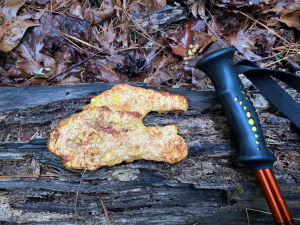
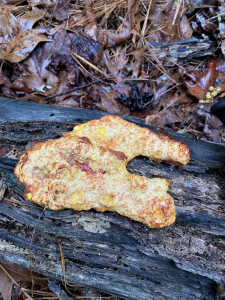
We found several other examples of this species, each one distinct from the others. All are memorable in their own way.
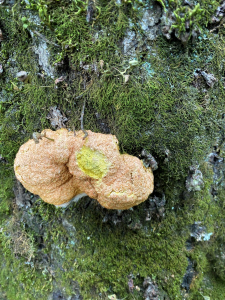
Deep in the shade of a cove forest we found a mid-canopy American beech with a distinct vertical delineation separating the lichen-coated north side from what I’ll describe as the sun-bleached southern exposure. I don’t recall previously seeing such a strong north-south divide. I can offer no other explanation.
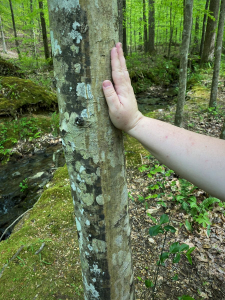
I shall continue to search for, examine, appreciate, and attempt to explain each and every forest oddity and curiosity.
Alabama State Parks Foundation
Thoughts and Reflections
I offer these observations:
- I relish finding and seeking to understand and explain tree form oddities.
- I find many curiosities; very few of them are total mysteries.
- Most of our supposed “marker trees” post-date Native American occupation here in north Alabama; Nature does the marking.
Inhale and absorb Nature’s elixir. May Nature Inspire, Inform, and Reward you!
Note: All blog post images created & photographed by Stephen B. Jones unless otherwise noted. Please circulate images with photo credit: “©2021 Steve Jones, Great Blue Heron LLC. All Rights Reserved.”
Another Note: If you came to this post via a Facebook posting or by an another route, please sign up now (no cost… no obligation) to receive my Blog Post email alerts: http://eepurl.com/cKLJdL
And a Third: I am available for Nature-Inspired Speaking, Writing, and Consulting — contact me at steve.jones.0524@gmail.com
Reminder of my Personal and Professional Purpose, Passion, and Cause
If only more of us viewed our precious environment through the filters I employ. If only my mission and vision could be multiplied untold orders of magnitude:
Mission: Employ writing and speaking to educate, inspire, and enable readers and listeners to understand, appreciate, and enjoy Nature… and accept and practice Earth Stewardship.
Vision:
- People of all ages will pay greater attention to and engage more regularly with Nature… and will accept and practice informed and responsible Earth Stewardship.
- They will see their relationship to our natural world with new eyes… and will understand more clearly their Earth home.
Tagline/Motto: Steve (Great Blue Heron) encourages and seeks a better tomorrow through Nature-Inspired Living!
Steve’s Three Books
I wrote my books Nature Based Leadership (2016), Nature-Inspired Learning and Leading (2017), and Weaned Seals and Snowy Summits: Stories of Passion for Place and Everyday Nature (2019; co-authored with Dr. Jennifer Wilhoit) to encourage all citizens to recognize and appreciate that every lesson for living, learning, serving, and leading is either written indelibly in or is powerfully inspired by Nature.
I began writing books and Posts for several reasons:
- I love hiking and exploring in Nature
- I see images I want to (and do) capture with my trusty iPhone camera
- I enjoy explaining those images — an educator at heart
- I don’t play golf!
- I actually do love writing — it’s the hobby I never needed when my career consumed me
- Judy suggested my writing is in large measure my legacy to our two kids, our five grand kids, and all the unborn generations beyond
- And finally, perhaps my books and Blogs could reach beyond family and touch a few other lives… sow some seeds for the future


All three of my books (Nature Based Leadership; Nature-Inspired Learning and Leading; Weaned Seals and Snowy Summits) present compilations of personal experiences expressing my (and co-author Dr. Wilhoit for Weaned Seals and Snowy Summits) deep passion for Nature. All three books offer observations and reflections on my relationship to the natural world… and the broader implications for society. Order any and all from your local indie bookstore, or find them on IndieBound or other online sources such as Amazon and LifeRich.

